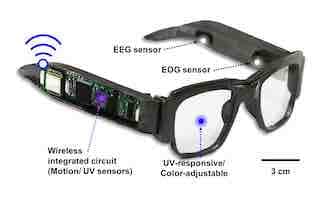By American Chemical Society ——Bio and Archives--May 27, 2020
Health and Medicine | CFP Comments | Reader Friendly | Subscribe | Email Us
 Fitness tracker bracelets and watches provide useful information, such as step count and heart rate, but they usually can’t provide more detailed data about the wearer’s health. Now, researchers reporting in ACS Applied Materials & Interfaces have developed smart electronic glasses (e-glasses) that not only monitor a person’s brain waves and body movements, but also can function as sunglasses and allow users to control a video game with eye motions.
Devices that measure electrical signals from the brain (electroencephalogram; EEG) or eyes (electrooculogram; EOG) can help diagnose conditions like epilepsy and sleep disorders, as well as control computers in human-machine interfaces. But obtaining these measurements requires a steady physical contact between skin and sensor, which is difficult with rigid devices. Suk-Won Hwang and colleagues wanted to integrate soft, conductive electrodes into e-glasses that could wirelessly monitor EEG and EOG signals, ultraviolet (UV) intensity, and body movements or postures, while also acting as a human-machine interface.
Fitness tracker bracelets and watches provide useful information, such as step count and heart rate, but they usually can’t provide more detailed data about the wearer’s health. Now, researchers reporting in ACS Applied Materials & Interfaces have developed smart electronic glasses (e-glasses) that not only monitor a person’s brain waves and body movements, but also can function as sunglasses and allow users to control a video game with eye motions.
Devices that measure electrical signals from the brain (electroencephalogram; EEG) or eyes (electrooculogram; EOG) can help diagnose conditions like epilepsy and sleep disorders, as well as control computers in human-machine interfaces. But obtaining these measurements requires a steady physical contact between skin and sensor, which is difficult with rigid devices. Suk-Won Hwang and colleagues wanted to integrate soft, conductive electrodes into e-glasses that could wirelessly monitor EEG and EOG signals, ultraviolet (UV) intensity, and body movements or postures, while also acting as a human-machine interface.View Comments
American Chemical Society, ACS is a congressionally chartered independent membership organization which represents professionals at all degree levels and in all fields of chemistry and sciences that involve chemistry.